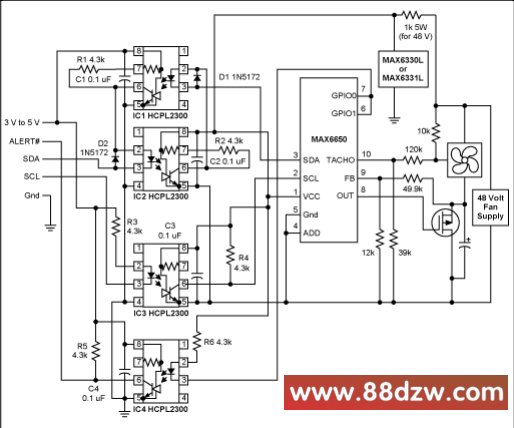Rev Up Your Fan Speed Control
[09-13 17:04:38] 来源:http://www.88dzw.com 控制技术 阅读:8723次
文章摘要:Isolated Fan DriveIn some systems the high fluctuating ground currents of fans cause noise problems due to ground loops. Ground loop problems are readily solved by galvanic isolation. The schematic of Figure 9 can be used to isolate any I²C or SMBus fan controller, including the previously ment
Rev Up Your Fan Speed Control,标签:计算机控制技术,工厂电气控制技术,http://www.88dzw.comIsolated Fan Drive
In some systems the high fluctuating ground currents of fans cause noise problems due to ground loops. Ground loop problems are readily solved by galvanic isolation. The schematic of Figure 9 can be used to isolate any I²C or SMBus fan controller, including the previously mentioned MAX1669 or MAX6650/MAX6651. The circuit shown takes advantage of the already isolated fan power supply so that the MAX6650/MAX6651 does not have to include a separate expensive isolated 5 volt DC-DC converter. The MAX6330/MAX6331 shunt regulator provides an economical and reliable way to regulate down from the 48 volts. The SOT23 package of the MAX6330/MAX6331 combined with the size of the 5 watt dropping resistor compare favorably to that of a pass regulator and heatsink. Furthermore, the 5 watt resistor is easier and less costly to install than a heatsink.
Figure 9. Isolated fan control circuits are useful where ground noise due to high fan currents can be a problem. IC1 and IC2 comprise a bi-directional digital isolator for the data line. Since the MAX6650/MAX6651 is only an input for clock, unidirectional isolation can be used for the clock with IC3. IC4 is an optional addition to couple.
In Figure 9 a bi-directional optical isolator circuit isolates the data line. The bi-directional isolator circuit has been described previously in references 1 and 2. IC1 and IC2 are connected together in such a way that a low on either side results in a low on the other side, without the isolator circuit latching.
Virtually all of the I²C and SMBus devices discussed here have clock pins that are input only (as opposed to some I²C ICs which can "stretch" the clock by holding the clock low). This simplifies isolation by requiring only a single unidirectional isolator. Most of these devices also have watchdog or alert outputs that can be coupled back to the controller with another unidirectional isolator.
Fan Speed Regulation As Opposed to Fan Speed Control
Closed loop fan control overcomes the inherent non-linearity involved in controlling DC brushless fans. Fan control then becomes fan speed regulation. Precise fan speed is assured even over variations from fan to fan and due to aging. Closed loop fan regulation is readily accomplished with available fan control and health monitoring ICs by using a closed loop amplifier circuit on their output. More recently, ICs are becoming available which provide closed loop fan speed regulation.These same methods are readily adaptable to circuits that address more limited needs. Many applications such as telecom use 48 volt fans, and these circuits and ICs can be adapted for that use. Galvanic isolation methods can solve messy ground loop problems that occasionally arise with large fan current spikes.
_____________________
- "Isolate Data Acquisition on a Bi-directional Bus", Jerry Steele, Electronic Design, November 6, 1995.
- "Temperature sensor uses I²C isolator", Jerry Steele, EDN, June 6, 1996.
Tag:控制技术,计算机控制技术,工厂电气控制技术,控制技术
《Rev Up Your Fan Speed Control》相关文章
- › Rev Up Your Fan Speed Control
- › Reverse Compatibility of the D
- › YAMAHAREV100效果器使用说明
- › 奥地利微电子推出获得FlexRay V2.1 Rev B认证
- 在百度中搜索相关文章:Rev Up Your Fan Speed Control
- 在谷歌中搜索相关文章:Rev Up Your Fan Speed Control
- 在soso中搜索相关文章:Rev Up Your Fan Speed Control
- 在搜狗中搜索相关文章:Rev Up Your Fan Speed Control
分类导航
最新更新




 当前位置:
当前位置: